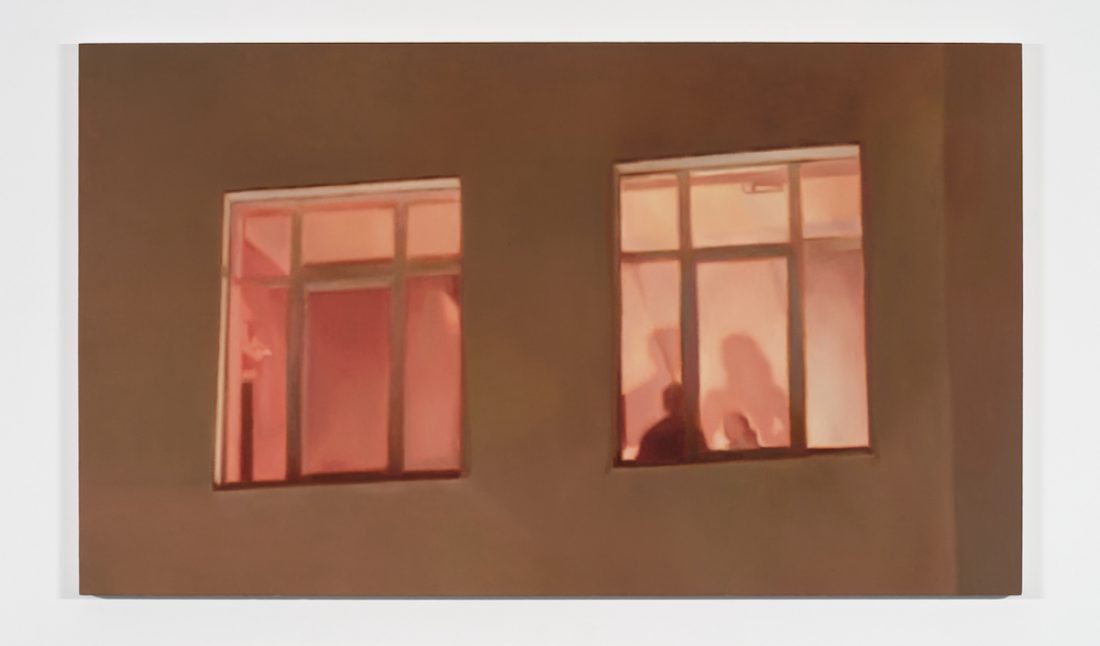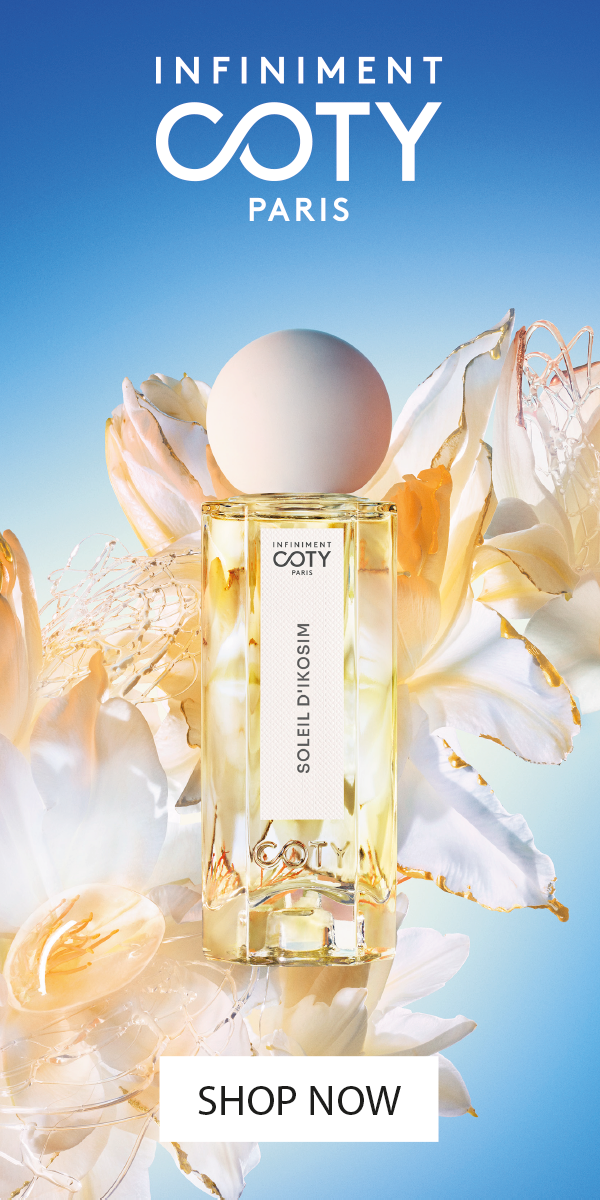Danny Sobor’s Show of New Paintings
Facing Danny Sobor’s studio in Brooklyn, NY is a newly-erected condo building, gilded in sleek, wide windows in service of a voyeuristic eye. The people living across from his studio on the third floor are not the curtain-hanging type, and neither is Sobor, whose studio window––while somewhat less sleek––is equally welcoming for those who like to watch.
Sobor’s solo exhibition, “Just a window. In,” was not inspired by his neighbors, though the amber palette and obscured figures likely gave them reason to wonder. Each painting is anonymous yet familiar, blurred and gleaming with light. Window panes, sills, shadows, and glimpses of figures populate the works, the peripheral details of broader happenings. A week before the opening of his show, Sobor mistakenly caught eyes with the woman living across the street. They looked at one another for a moment, as if to say, “I secretly know you very well.” Perhaps the neighbor was wondering, “Is it me who you’re painting?”
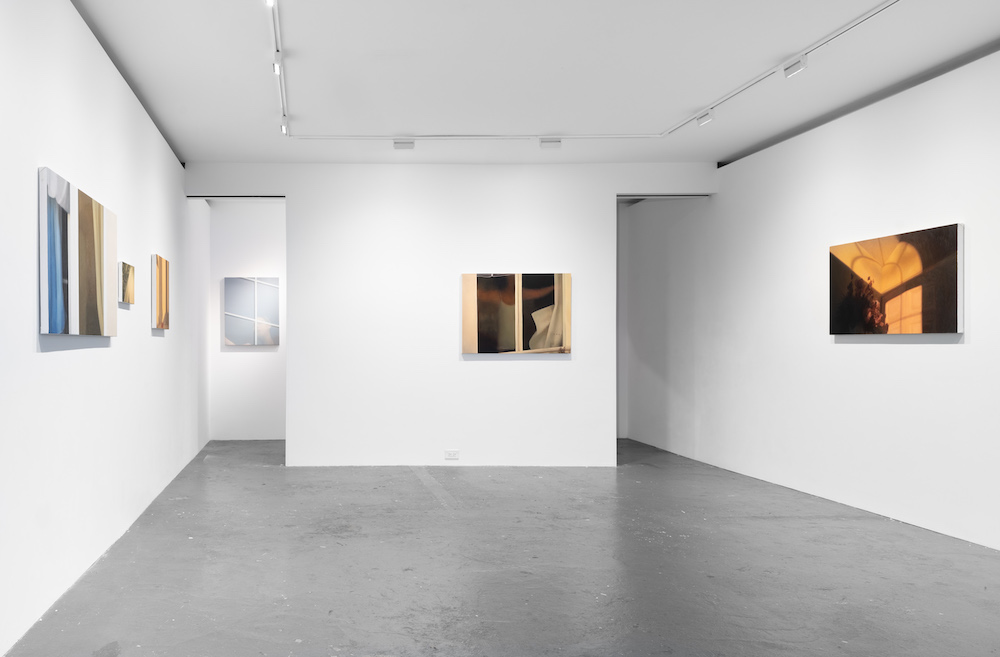 Installation view of Danny Sobor’s “Just a window. In,” courtesy of the artist and Fortnight Institute.
Installation view of Danny Sobor’s “Just a window. In,” courtesy of the artist and Fortnight Institute.
A Window Into a Greater Story
Today, these mysterious works hang weightlessly upon the walls of Fortnight Institute in New York, filling the gallery with an afterglow conjured from washes of thin oil paint. Like his neighbors eyeing him from a distance, Sobor seeks his subjects over periods of time––not through windows, but online. He patiently employs reverse image searches, exchanging found photos for similar iterations across an infinite internet. Historically, oil paintings are photographed to record their appearance and condition. Here, oil paint serves as the archival tool, preserving digital images otherwise left to decay. The painting itself is evidence of a greater story, a precious trace of something we observers can never fully see.
WHITEWALL: I’d like to start by talking about how you choose your reference images––there’s a really anonymous feel, almost universal. The scenes could be from almost anywhere, and we’re left with the sense that there’s something essential hidden beyond the frame.
DANNY SOBOR: I start by sifting through thousands of images on Yandex. I started using it because I noticed that it had a really powerful reverse image search––a lot better than Google. It doesn’t particularly care about context or language or source. On each page, you’ll be looking at the thumbnails, and some are coming from a porn site in Bangladesh or a French Facebook page with an ad for an Instagram masseuse. It’s a horizontal poll. You have this sea of images from all over. Sometimes I’ll follow the links associated with certain images and end up on sites with videos that have nothing to do with the thumbnail. There are always these broken links and crossed connections.
When you put an image into Yandex, it gives you a lot of things that look almost exactly like what you put in, and that’s always exciting. The searches can happen over years. For example, I reverse image searched a photo of a hand over a car door. In one of the results, I saw the edge of a head in the frame. I decided that I liked it, so I put this newly found image back through and over time found an entire face, and then I searched the face. The process becomes this recursive building of visual language.
I usually look for images that feel like they’re in the vein of a figurative painting but stripped down to as little information as possible. There’s a pretty rigorous editing process. I’d say I pick one photo that might be a good painting or make for something engaging for every 200 to 300 that I see––maybe more. Around six or eight months ago, I hit a thread where the results looked like ready-made paintings. They were these disintegrating images, really low-res thumbnails, 200 pixels tops. I couldn’t figure out exactly where they were coming from; they felt so ephemeral and momentary. I found this image of what is ostensibly the ghost of Princess Diana appearing in a cathedral. Afterwards, I did a cross-country road trip, and that image was in the back of my head the entire time. It stayed there until I painted it, haunting me.
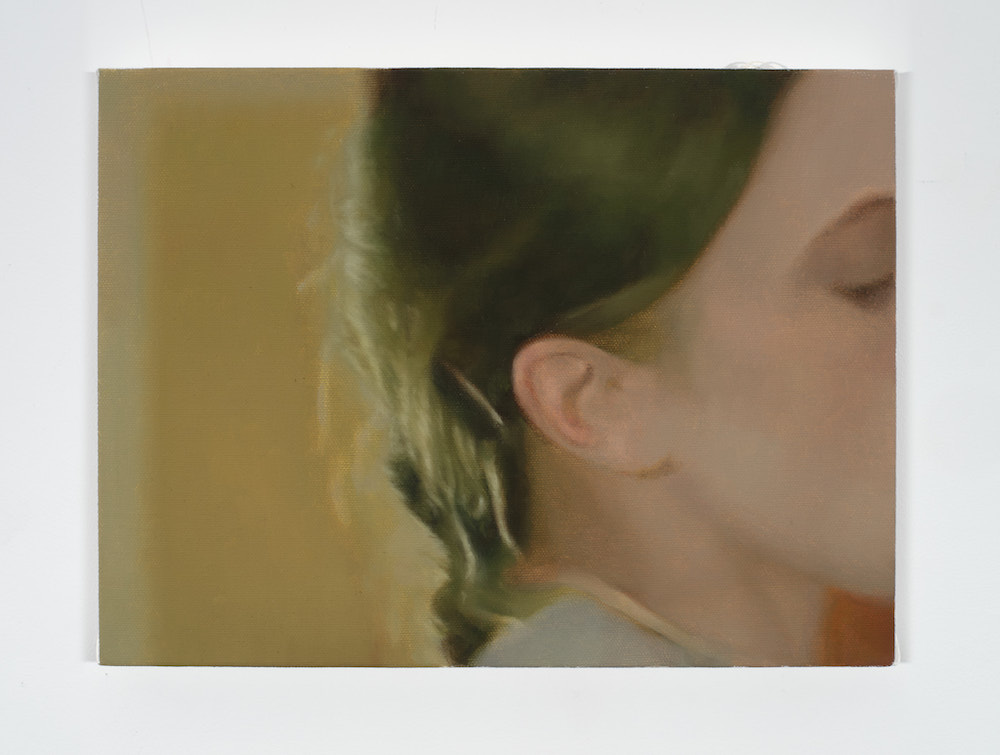 Danny Sobor, “neighbor,” 2023, oil on canvas, 12 x 9 inches, courtesy of the artist and Fortnight Institute.
Danny Sobor, “neighbor,” 2023, oil on canvas, 12 x 9 inches, courtesy of the artist and Fortnight Institute.
Danny Sobor Searches for a Specific Feeling in a Painting
WW: Your process feels like digital archeology. Is there a particular element in these images that you’re looking for or feel is important to preserve?
DS: I think there’s something about taking something that’s extremely low––borderline discarded––and putting that back into oil painting, oil being a traditionally high medium. That interplay excites me. I’ve been remembering the Gestalt theory of cognition and this idea of filling in the gaps. For example, if you’re looking at the ocean and in front of it are a bunch of trees with leaves, you can’t see the whole ocean but your mind still recognizes it. Two-thirds of your field of vision is branches and leaves, but you still know that what’s behind it is this ocean. You can follow the waves, you can follow the birds.
I think––and I’m not sure––but I think I’m probably making the same painting over and over and trying to get at something inside me that is that ocean. If the image is going to work as a painting, it makes my stomach sink in the right way. And so I’m searching for the same feeling or idea and transcribing it in different ways. But that’s why I think you can put these paintings together despite their disparate sourcing. They’re all coming from the same place; putting them through my hand creates the umbrella that they exist under. I think my hand is smarter than I am. I like letting the photo be a formal structure, and letting my hand freely fill it in. My hand unifies everything.
WW: And speaking of Gestalt, there’s the idea that it’s impossible to understand someone without considering their environment and experience. And here you are taking these images out of their context and there’s a sense that we’ll never be able to completely understand them…
DS: The two words I heard most about the show are “familiar” and “haunting.” And again, when you make a painting like these, which are still photo-adjacent, it’s tough to put too much onto them after they’re made. They’re just out in the open. If I’m finding something familiar and haunting it in the image to begin with, I guess it’s being transcribed. I don’t necessarily know why, other than that I keep going back to that stomach drop feeling, or some kind of a shimmer, then it’s there.
As far as context goes, I think I’m too close to them. Their context is already truncated. The narrative that they were once a part of might be a cut scene in a porn or the first frame in an iFunny video. So they’re already kind of non-narrative entry points being isolated from that more.
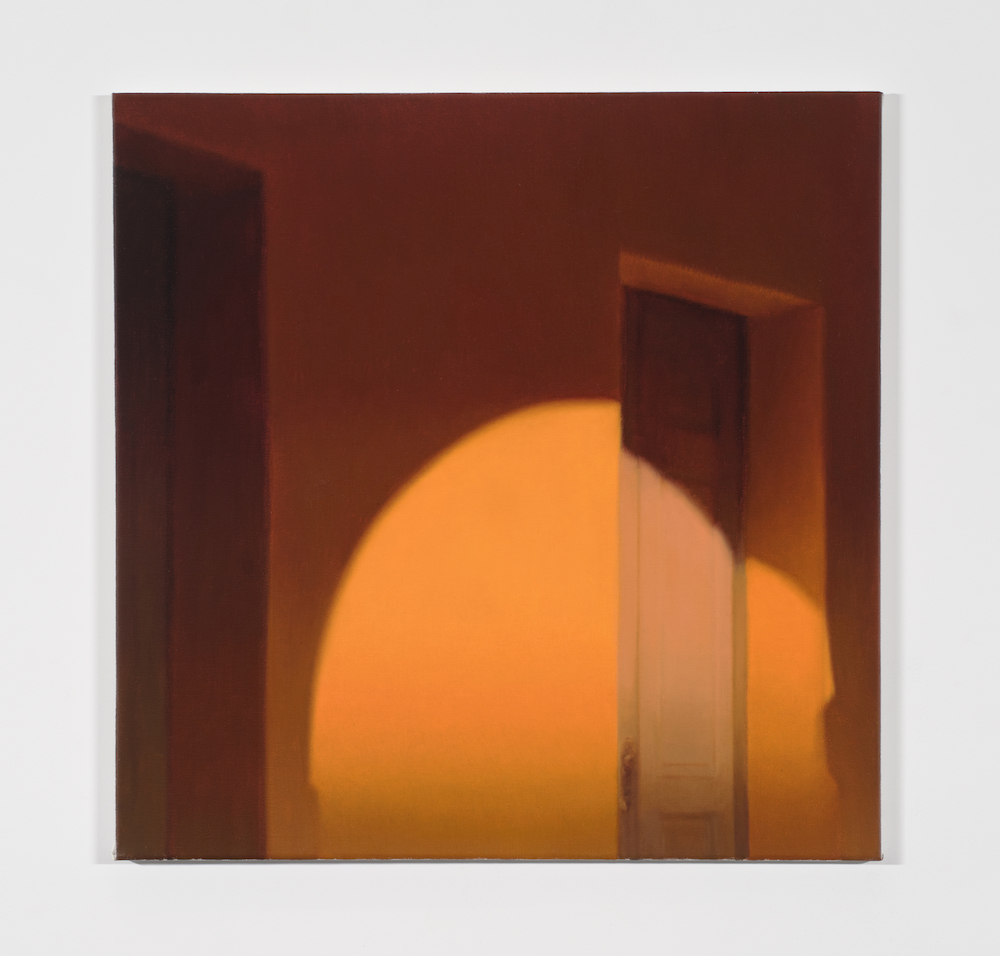 Danny Sobor, “day,” 2023, oil on canvas, 20 x 20 inches, courtesy of the artist and Fortnight Institute.
Danny Sobor, “day,” 2023, oil on canvas, 20 x 20 inches, courtesy of the artist and Fortnight Institute.
Danny Sobor’s Paintings Sit on the Border of the Familiar
WW: There’s an idea in psychology that attraction is always about a balance of what is familiar enough to be safe and novel enough to be exciting. The scenes that you choose certainly have that balance. There’s a mystery because they’re not so haunting; it’s just a very subtle element.
DS: Yes, that is a conscious choice. I have internal criteria when I’m looking at imagery and seeking that moment. When we were first putting the show together, I was considering more voyeuristic images, like men peering through windows or doors. But even adding one into the group completely changed it. The whole room immediately became way freakier. There is definitely a balance to strike.
Something always in the back of my mind is the Trojan Horse, the idea that these images present as one thing but are actually something else. Maybe if you quickly look at them, it’s: “That’s a woman’s hair. She’s in a green room.” But when you sit with them there’s more curiosity. Why is it this snippet? Where is this coming from? Especially in knowing that some of the sources are from very seedy places, I like having the painting sit on the border of a familiar memory stripped of its kindness or warmth or welcome nostalgia.
WW: There are a lot of elements of this work coming from new media and video. I’m curious if you’re thinking about new media or photography or film outside of the studio.
DS: Not at all. I am actually really scared of cameras in a lot of ways. I don’t really like being photographed, and I get scared when my paintings are photographed because of the way the colors get lost. I don’t think our devices really capture them. Obviously I paint with the knowledge that 95% of people are going to see my paintings on an Instagram square, the camera matters, but I resent it. And I think that resentment translates into really loving the material and really trying to make all the blurs and the edges perceptually engaging and quiet. I’ll put in small greens and small reds just because I want them to shimmer in person, even if it’s lost in a photo.
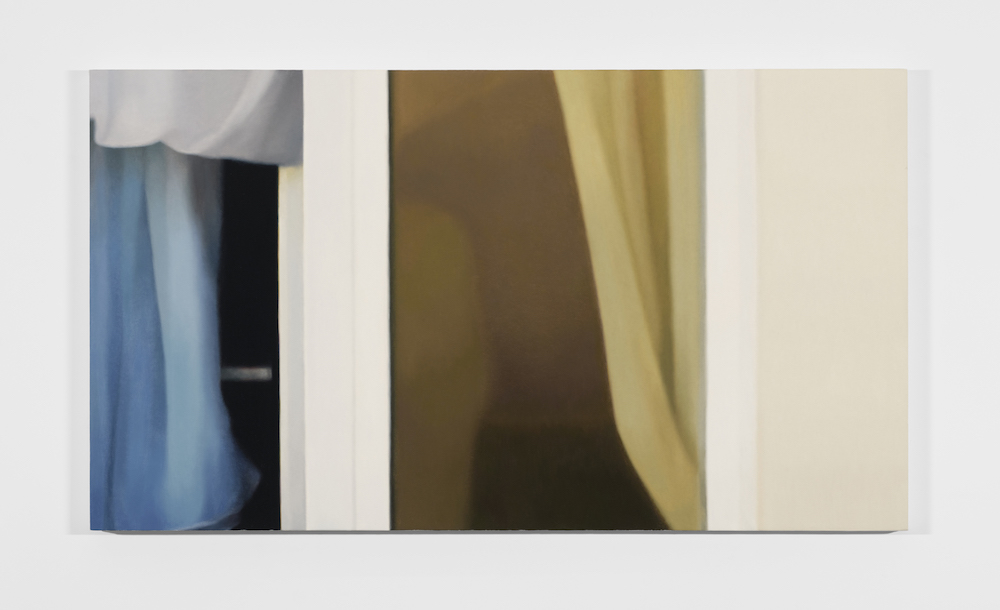 Danny Sobor, “private,” 2023, oil on canvas, 46 x 26 inches, courtesy of the artist and Fortnight Institute.
Danny Sobor, “private,” 2023, oil on canvas, 46 x 26 inches, courtesy of the artist and Fortnight Institute.
WW: What about your painting influences?
DS: I mean, obviously Richter looms. My favorite painter is Eberhard Havekost, a Richter protegé, and he continued what Richter did with photo painting and the blur to those large abstraction squeegee paintings. He’ll take very strange angles and closeups and almost make a geometric painting or a very formal color field painting out of the exterior of a building or out of the closeup of a pair of lips. He’s the only painter I let into my head in the studio––I love his edges and I love his compositions and how they don’t give you everything, but you still seem to know what they are.
It feels like at this moment, I’m seeing a lot more ghost painting in general, a lot of spectral stuff, a lot of blurry stuff, soft stuff. I think there’s a creeping uncertainty in so much today; you never know what’s a deep fake. You don’t know what’s real on the news. There are so many inputs coming in and that uncertainty is showing itself in the type of photo painting I’m doing. I’m working in that lineage.
Working in the Lineage of Richter
WW: The press release mentions that the paints used for the show once belonged to your late father––there’s an added layer of memory and repurposing. Do you mind speaking more about that decision and its significance?
DS: Last spring, I found myself in a bit of a rut and a moment of experimentation. My color scheme used to be a lot colder––there was a lot more phthalo blue, and I always hated brown. I think brown paint––at least Burnt Umber and Sienna––feels like shit.
My dad had painted occasionally, and I had these old paints of his tucked away that I was always scared to use. He passed unexpectedly in 2019, and it had felt too charged to paint with them, but I found myself in a moment of freedom––a kind of “smoke ’em if you got ‘em” situation. I laid out some canvases on the floor and started making little abstracts, just seeing how his paint felt. I found transparent oxide red, a color I had never used. Finally, there was a brown that I loved. It’s very hot, and painted thin, it’s the hottest orange rust, almost crimson. It’s really gorgeous. I don’t think I would’ve ever found it otherwise––it felt like a gift. It became the basis for the show’s palette, somewhere in nearly every painting.
I used almost the entire tube for this show, so there’s a layered element of ephemerality: these images are disappearing and becoming ghosts, and then the paint itself is a relic. I liked that interplay. It was scary, but I found moments of liberation or acceptance as I squeezed out a big chunk and thought, “Okay, well, I have to use this. It’s better that I’m using it than not.” It brought some closure. I think that energy comes into the paintings, especially Geist, the woman with her arms out towards the end. In a way, the woman in the window is a portrait of my father; she is a ghost. On top of that, there’s the obviously Christlike pose, but she’s also from a voyeur video from a trashy website. I like that in a painting; I like that it’s all those things weaving in and out.
When I’m making these, I go out on an island. They’re marathon sessions. I’ll do 14 hours per day for five or six days; everything’s alla prima, so it’s very thin and it dries fast. When I’m in that zone, I’m very meditative. Sometimes I feel I can remember better. Outside chatter diminishes and I’m left remembering him or talking to him. Using the paints gave me some pride. It felt like both a triumph and a resolution.
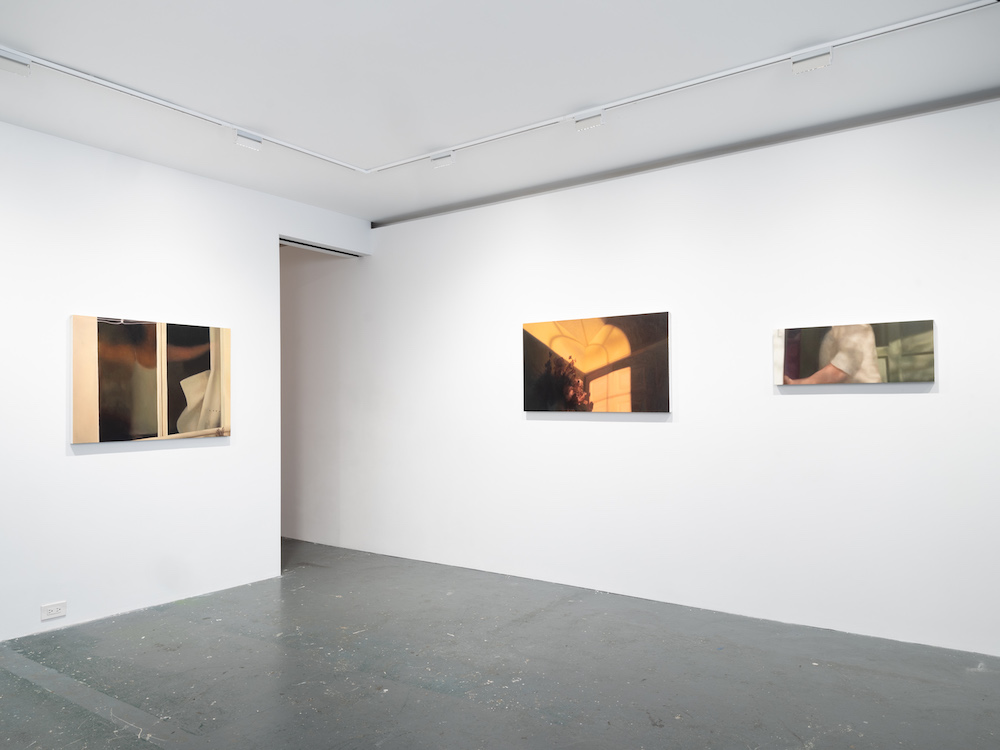 Installation view of Danny Sobor’s “Just a window. In,” courtesy of the artist and Fortnight Institute.
Installation view of Danny Sobor’s “Just a window. In,” courtesy of the artist and Fortnight Institute.
WW: Finally, what are you thinking about when you’re not thinking about painting?
DS: Lately, I’ve been thinking about mastery and about how little we can know. I don’t trust people who claim to have the answer to something. It is really hard to find the truth if there is one. There’s this undulating unknown, and the best you can do is hit it with pinpricks of light from different places; you’ll never get the full topography. But, maybe for a moment you’ll find something that feels pure, whether that’s in writing or film or painting. I’m thinking about that.
Danny Sobor: “Just a window. In” remains on view at Fortnight Institute through December 23, 2023. For inquiries, please contact Fortnight Institute at enquiries@fortnight.institute.







